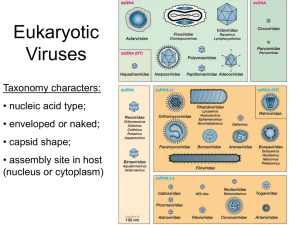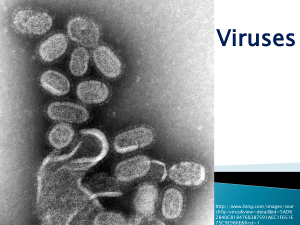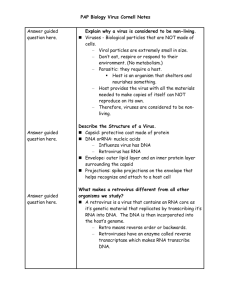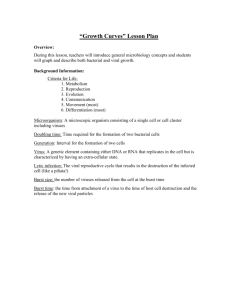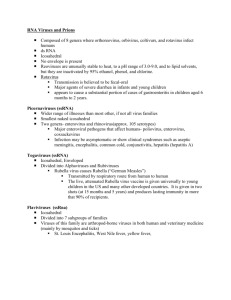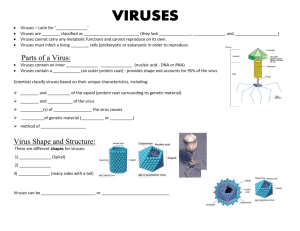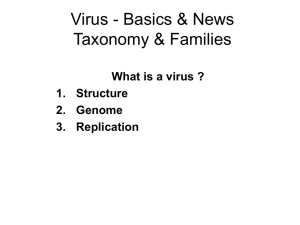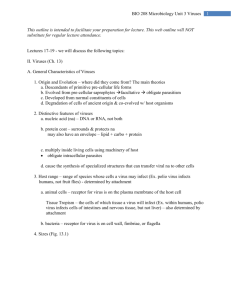Preface
advertisement
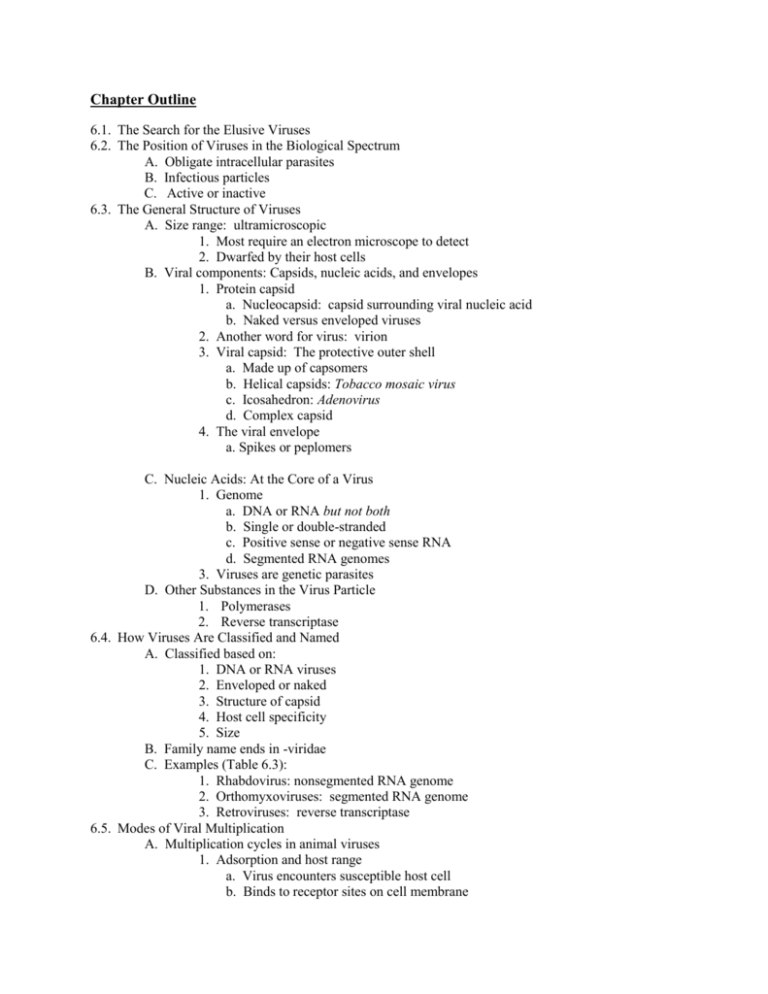
Chapter Outline 6.1. The Search for the Elusive Viruses 6.2. The Position of Viruses in the Biological Spectrum A. Obligate intracellular parasites B. Infectious particles C. Active or inactive 6.3. The General Structure of Viruses A. Size range: ultramicroscopic 1. Most require an electron microscope to detect 2. Dwarfed by their host cells B. Viral components: Capsids, nucleic acids, and envelopes 1. Protein capsid a. Nucleocapsid: capsid surrounding viral nucleic acid b. Naked versus enveloped viruses 2. Another word for virus: virion 3. Viral capsid: The protective outer shell a. Made up of capsomers b. Helical capsids: Tobacco mosaic virus c. Icosahedron: Adenovirus d. Complex capsid 4. The viral envelope a. Spikes or peplomers C. Nucleic Acids: At the Core of a Virus 1. Genome a. DNA or RNA but not both b. Single or double-stranded c. Positive sense or negative sense RNA d. Segmented RNA genomes 3. Viruses are genetic parasites D. Other Substances in the Virus Particle 1. Polymerases 2. Reverse transcriptase 6.4. How Viruses Are Classified and Named A. Classified based on: 1. DNA or RNA viruses 2. Enveloped or naked 3. Structure of capsid 4. Host cell specificity 5. Size B. Family name ends in -viridae C. Examples (Table 6.3): 1. Rhabdovirus: nonsegmented RNA genome 2. Orthomyxoviruses: segmented RNA genome 3. Retroviruses: reverse transcriptase 6.5. Modes of Viral Multiplication A. Multiplication cycles in animal viruses 1. Adsorption and host range a. Virus encounters susceptible host cell b. Binds to receptor sites on cell membrane c. Host range is limited to cells with specific receptors for that virus i. Hepatitis B: liver cells of humans only ii. Poliovirus: intestinal cells of primates iii. Rabies virus: various cells of all mammals 2. Penetration/uncoating of animal viruses a. Endocytosis: entire virus is engulfed by cell into a vacuole b. Uncoating: enzymes in vacuole dissolve envelope and capsid c. Viral nucleic acid is released into cytoplasm d. Fusion can also occur 3. Synthesis: Replication and protein production a. Viral nucleic acid controls host’s metabolic machinery b. DNA viruses usually work from nucleus c. RNA viruses usually work from cytoplasm 4. Assembly of animal viruses: Host cell as factory a. Capsid is laid down as empty shell b. Nucleic acid strand is added c. Enveloped viruses bud off from host’s cell membrane 5. Release of mature viruses: a. Lysis or Budding (exocytosis) 6. Damage to the host cell and persistent infections a. Cytopathic effects b. Inclusion bodies c. Persistent infection d. Latent state e. Transformation f. Oncogenic viruses, oncoviruses: i. Epstein-Barr virus B. Viruses that infect bacteria 1. Life cycle of T-even bacteriophages a. Adsorption to the host cell surface using bacterial receptors b. Bacteriophage penetration: entry of the nucleic acid c. Bacteriophage assembly line d. Release of bacteriophage: lysis of bacterial cells 2. Lysogeny: The silent virus infection a. Temperate phages b. Prophage c. Induction d. Lysogeny compared with the lytic cycles e. Lysogenic conversion 6.6. Techniques in Cultivating and Identifying Animal Viruses A. Purposes of viral cultivation: 1. Isolate and identify viruses in clinical specimens 2. To prepare viruses for vaccines 3. Research on viral structure, multiplication, genetics, and effects on host cells B. Using live animal inoculation C. Using bird embryos D. Using cell (tissue) culture techniques 1. Primary cell culture 2. Cell lines 3. Plaques 6.7. Other non-cellular infectious agents 1. Prions a. Creutzfeldt-Jakob disease b. Bovine spongiform encephalitis 2. Satellite viruses a. The delta agent (only in presence of hepatitis B virus) 3. Viroids a. Naked infectious RNA fragments b. Plant infections 6.8. Viruses and human health Treatment of Animal Viral Infections A. Interferon B. Vaccines
